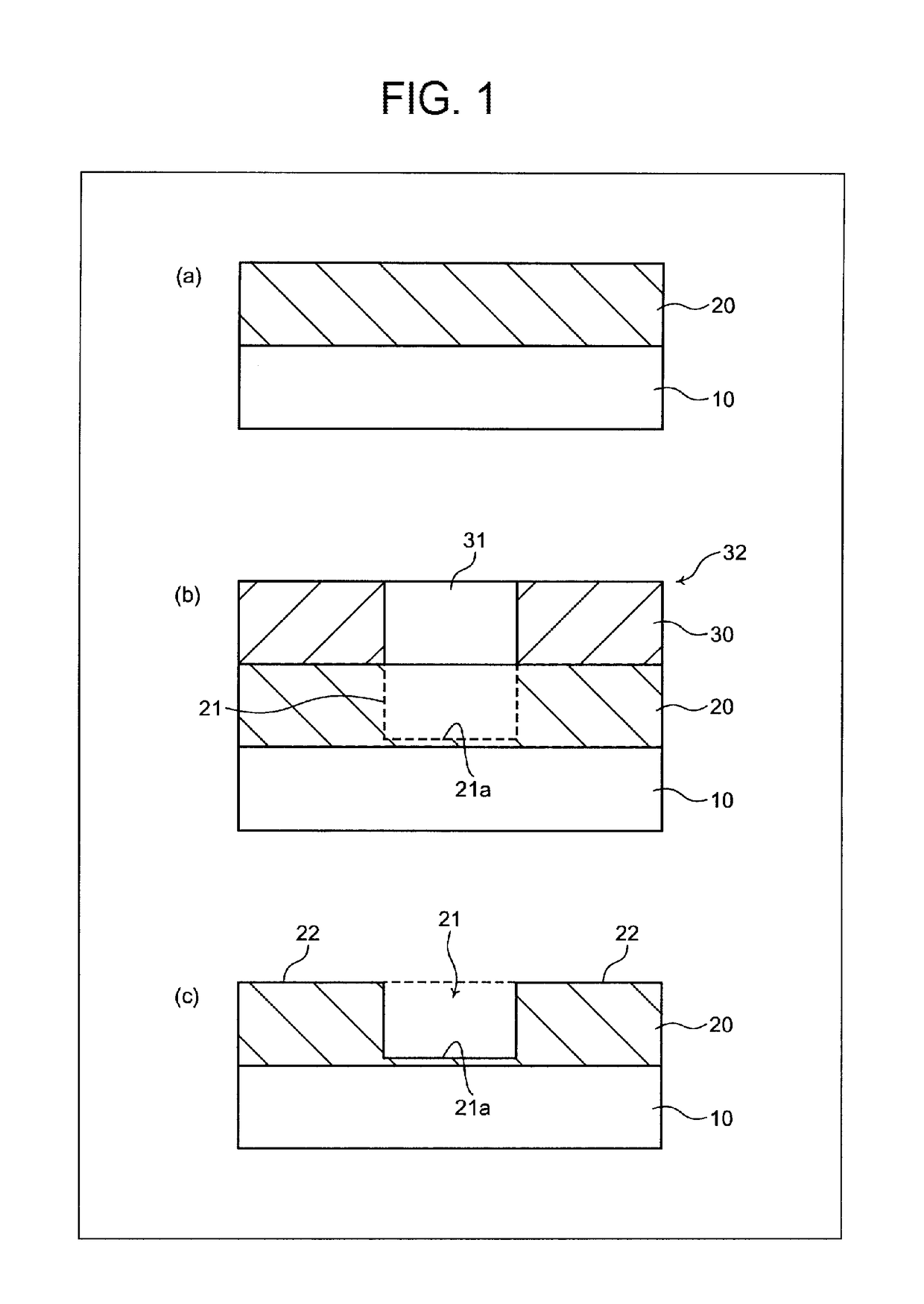Method for manufacturing a silicon carbide semiconductor element
a semiconductor element and manufacturing method technology, applied in semiconductor devices, semiconductor/solid-state device testing/measurement, electrical apparatus, etc., can solve the problems of difficult to remove resists, physical properties of carbide semiconductors, difficult control dimensions, etc., to reduce breakdown voltage, improve breakdown voltage, and reduce breakdown voltage
- Summary
- Abstract
- Description
- Claims
- Application Information
AI Technical Summary
Benefits of technology
Problems solved by technology
Method used
Image
Examples
embodiment 1
[0029]A method for manufacturing a silicon carbide semiconductor element according to Embodiment 1 of the invention will be described. FIG. 1 is a cross-sectional view illustrating a process of manufacturing the silicon carbide semiconductor element according to Embodiment 1 of the invention.
[0030]First, as illustrated in FIG. 1(a), for example, an n− silicon carbide single-crystal substrate (hereinafter, referred to as an n− silicon carbide substrate) 10 which is made of four-layer periodic hexagonal silicon carbide (4H—SiC) and in which an n− silicon carbide epitaxial layer is formed on one main surface of an n+ silicon carbide substrate is prepared.
[0031]Then, an inorganic insulating film 20 which functions as an ion implantation mask is deposited (formed) with a thickness of 1 μm on the main surface of the n− silicon carbide substrate 10. Then, as illustrated in FIG. 1(b), a photoresist 30 is applied onto the surface of the inorganic insulating film 20 and exposure and developme...
embodiment 2
[0049]Next, a method for manufacturing a silicon carbide semiconductor element according to Embodiment 2 will be described. FIG. 4 is a cross-sectional view illustrating the shape of an ion implantation mask according to Embodiment 2 of the invention. An inorganic insulating film 20 which functions as an ion implantation mask is deposited with a thickness of 1 μm on a main surface of an n− silicon carbide substrate 10, a photoresist 30 is applied onto the surface of the inorganic insulating film 20, and a resist pattern 32 is formed by the same processes as those in Embodiment 1. Then, dry etching is performed using the resist pattern 32 as a mask.
[0050]When the etching time is manually set, the initial thickness of a film, the thickness of a residual film, and the etching rate are calculated by the same method as that in Embodiment 1. When the thickness of the residual film is 400 nm and the etching rate is 60 nm per minute, etching is performed for 6.7 minutes to manufacture the i...
example
[0055]Next, the verification result of the surface shape of an opening portion 21 of a silicon carbide semiconductor element which is manufactured by the method for manufacturing the silicon carbide semiconductor element according to the embodiment of the invention will be described. FIG. 6 is a cross-sectional view illustrating a manufactured MOSFET.
[0056]First, a SiO2 film with a thickness of 1.5 μm was formed using an atmospheric pressure CVD apparatus on an n− silicon carbide substrate (the upper surface of an n− silicon carbide epitaxial layer 60), which was made of four-layer periodic hexagonal silicon carbide (4H—SiC) and in which the n− silicon carbide epitaxial layer 60 was formed on an n+ silicon carbide substrate. Then, an ion implantation mask 20 was formed on the n− silicon carbide substrate according to the embodiment and Al ions were implanted through the opening portion 21 to form a p region (p base layer) 61 in a surface layer of the n− silicon carbide substrate (a ...
PUM
| Property | Measurement | Unit |
|---|---|---|
| thickness | aaaaa | aaaaa |
| temperature | aaaaa | aaaaa |
| thickness | aaaaa | aaaaa |
Abstract
Description
Claims
Application Information
 Login to View More
Login to View More - R&D
- Intellectual Property
- Life Sciences
- Materials
- Tech Scout
- Unparalleled Data Quality
- Higher Quality Content
- 60% Fewer Hallucinations
Browse by: Latest US Patents, China's latest patents, Technical Efficacy Thesaurus, Application Domain, Technology Topic, Popular Technical Reports.
© 2025 PatSnap. All rights reserved.Legal|Privacy policy|Modern Slavery Act Transparency Statement|Sitemap|About US| Contact US: help@patsnap.com



